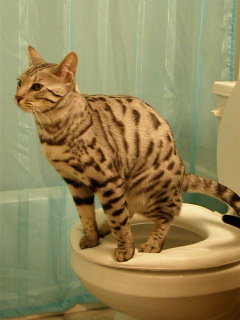This post listed below in relation to Don’t flush cat feces down the toilet is particularly enjoyable. Check it out for yourself and see what you think about it.

Intro
As feline proprietors, it's important to bear in mind exactly how we deal with our feline buddies' waste. While it may seem convenient to purge cat poop down the commode, this technique can have destructive consequences for both the atmosphere and human health.
Alternatives to Flushing
Fortunately, there are more secure and more liable ways to throw away feline poop. Consider the complying with choices:
1. Scoop and Dispose in Trash
The most usual technique of taking care of cat poop is to scoop it right into a biodegradable bag and toss it in the trash. Make sure to use a dedicated litter inside story and deal with the waste quickly.
2. Usage Biodegradable Litter
Go with biodegradable feline trash made from materials such as corn or wheat. These litters are environmentally friendly and can be safely gotten rid of in the garbage.
3. Bury in the Yard
If you have a backyard, think about burying cat waste in a marked location away from veggie yards and water sources. Be sure to dig deep enough to avoid contamination of groundwater.
4. Set Up a Pet Waste Disposal System
Purchase a family pet garbage disposal system particularly designed for pet cat waste. These systems utilize enzymes to break down the waste, minimizing odor and ecological impact.
Wellness Risks
In addition to environmental worries, flushing pet cat waste can likewise posture health risks to humans. Cat feces might consist of Toxoplasma gondii, a bloodsucker that can trigger toxoplasmosis-- a potentially serious ailment, particularly for expecting women and people with weakened body immune systems.
Ecological Impact
Purging pet cat poop introduces dangerous virus and bloodsuckers right into the supply of water, posturing a considerable threat to water communities. These contaminants can adversely impact aquatic life and compromise water quality.
Verdict
Accountable pet dog ownership expands past offering food and sanctuary-- it additionally involves correct waste monitoring. By avoiding flushing feline poop down the toilet and choosing alternative disposal approaches, we can reduce our ecological impact and protect human health and wellness.
Why Can’t I Flush Cat Poop?
It Spreads a Parasite
Cats are frequently infected with a parasite called toxoplasma gondii. The parasite causes an infection called toxoplasmosis. It is usually harmless to cats. The parasite only uses cat poop as a host for its eggs. Otherwise, the cat’s immune system usually keeps the infection at low enough levels to maintain its own health. But it does not stop the develop of eggs. These eggs are tiny and surprisingly tough. They may survive for a year before they begin to grow. But that’s the problem.
Our wastewater system is not designed to deal with toxoplasmosis eggs. Instead, most eggs will flush from your toilet into sewers and wastewater management plants. After the sewage is treated for many other harmful things in it, it is typically released into local rivers, lakes, or oceans. Here, the toxoplasmosis eggs can find new hosts, including starfish, crabs, otters, and many other wildlife. For many, this is a significant risk to their health. Toxoplasmosis can also end up infecting water sources that are important for agriculture, which means our deer, pigs, and sheep can get infected too.
Is There Risk to Humans?
There can be a risk to human life from flushing cat poop down the toilet. If you do so, the parasites from your cat’s poop can end up in shellfish, game animals, or livestock. If this meat is then served raw or undercooked, the people who eat it can get sick.
In fact, according to the CDC, 40 million people in the United States are infected with toxoplasma gondii. They get it from exposure to infected seafood, or from some kind of cat poop contamination, like drinking from a stream that is contaminated or touching anything that has come into contact with cat poop. That includes just cleaning a cat litter box.
Most people who get infected with these parasites will not develop any symptoms. However, for pregnant women or for those with compromised immune systems, the parasite can cause severe health problems.
How to Handle Cat Poop
The best way to handle cat poop is actually to clean the box more often. The eggs that the parasite sheds will not become active until one to five days after the cat poops. That means that if you clean daily, you’re much less likely to come into direct contact with infectious eggs.
That said, always dispose of cat poop in the garbage and not down the toilet. Wash your hands before and after you clean the litter box, and bring the bag of poop right outside to your garbage bins.
https://trenchlesssolutionsusa.com/why-cant-i-flush-cat-poop/

Do you really like reading about Don’t flush cat feces down the toilet? Write a short review down below. We'd be glad to know your ideas about this blog posting. We are looking forward to see you back again before long. You should take the opportunity to share this blog if you enjoyed reading it. Many thanks for going through it.
Click Here